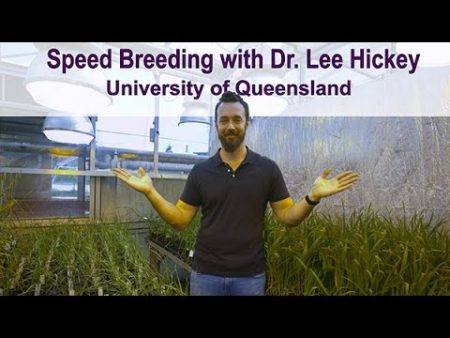January 4, 2018 – NASA has been experimenting with technologies to help grow staple crops on the International Space Station (ISS) with the ultimate goal to make it possible for future human crewed expeditions self-sustaining in terms of food supply. One technique being attempted is called speed breeding and it has produced accelerated growth in plants on the ISS.
The University of Queensland, in Australia, decided to use NASA’s speed breeding techniques here on Earth to “accelerate the genetic gain” states Dr. Lee Hickey, Senior Research Fellow at the Queensland Alliance for Agriculture and Food Innovation.
What is meant by genetic gain? It is the net improvement in the genome of plants and animals through changed externalities such as the changing of growing conditions, or genetic modifications. In the case of the Queensland experiment the change was applying the NASA speed breeding protocol to reduce the length of each plant breeding cycle.
Hickey explains. “By using speed breeding techniques in specially modified glasshouses we can grow six generations of wheat, chickpea and barley plants, and four generations of canola plants in a single year – as opposed to two or three generations in a regular glasshouse or a single generation in the field. By using speed breeding techniques in specially modified glasshouses we can grow six generations of wheat, chickpea and barley plants, and four generations of canola plants in a single year – as opposed to two or three generations in a regular glasshouse or a single generation in the field.”
The application of this technique could help global food production meet the challenge of rising world population expected to exceed 9 billion by 2050. The Queensland success has led to a partnership with Dow AgroSciences and the development of a new variety of wheat called DS Faraday which will be introduced this year for farmers. This new variety of wheat includes grain dormancy genes. Seed dormancy is a critical mechanism that impacts viable grain seeds negatively affecting optimal germination under a range of environmental conditions.
In a paper published on January 1, 2018, in the journal, Nature Plants, Hickey and his colleagues describe how the application of speed breeding techniques shortened generation time to achieve 6 generations of spring wheat, durum wheat, barley, chickpea and pea harvest, and 4 generations of canola in a single year.
What is needed to do speed breeding?
Queensland built fully enclosed environment growth chambers with continuous lighting producing accelerated plant development leading to improvements to the overall genome of species being grown. In the abstract the team states, “We envisage great potential for integrating speed breeding with other modern crop breeding technologies, including high-throughput genotyping, genome editing and genomic selection, accelerating the rate of crop improvement.”
Hickey also sees speed breeding as a useful vertical farming technology that could dramatically increase yields in urban farms.








